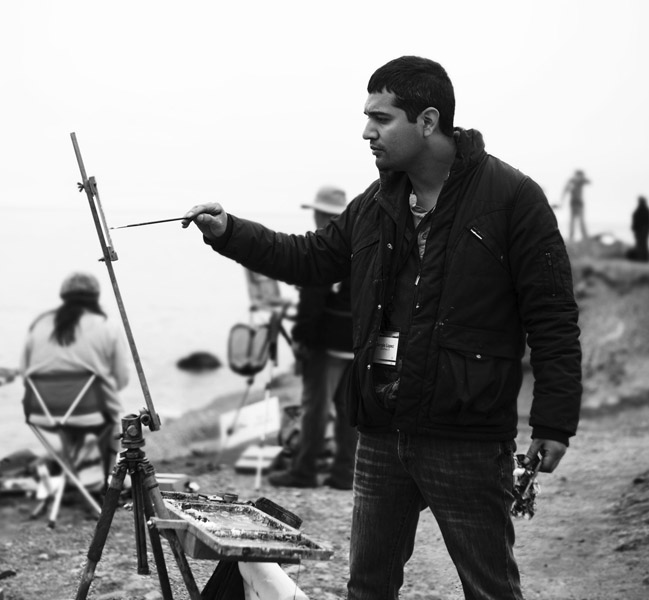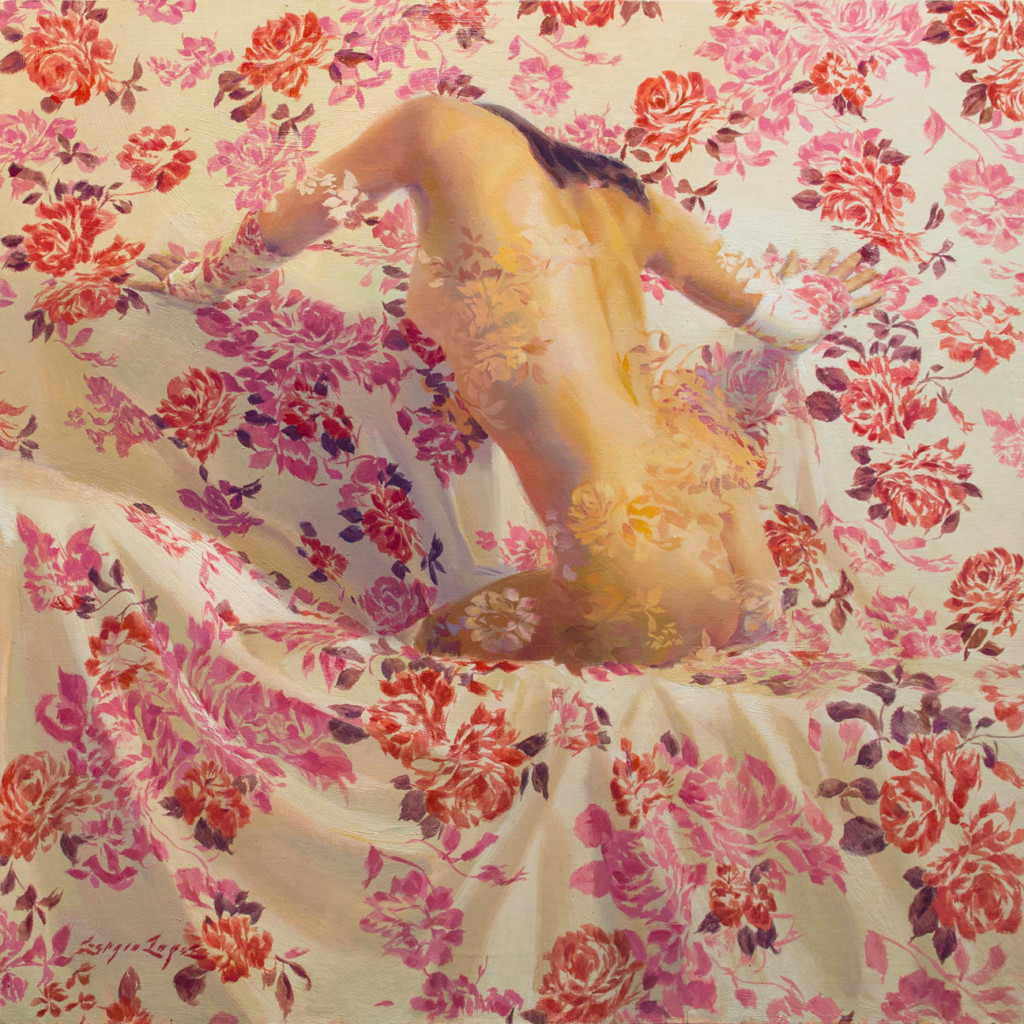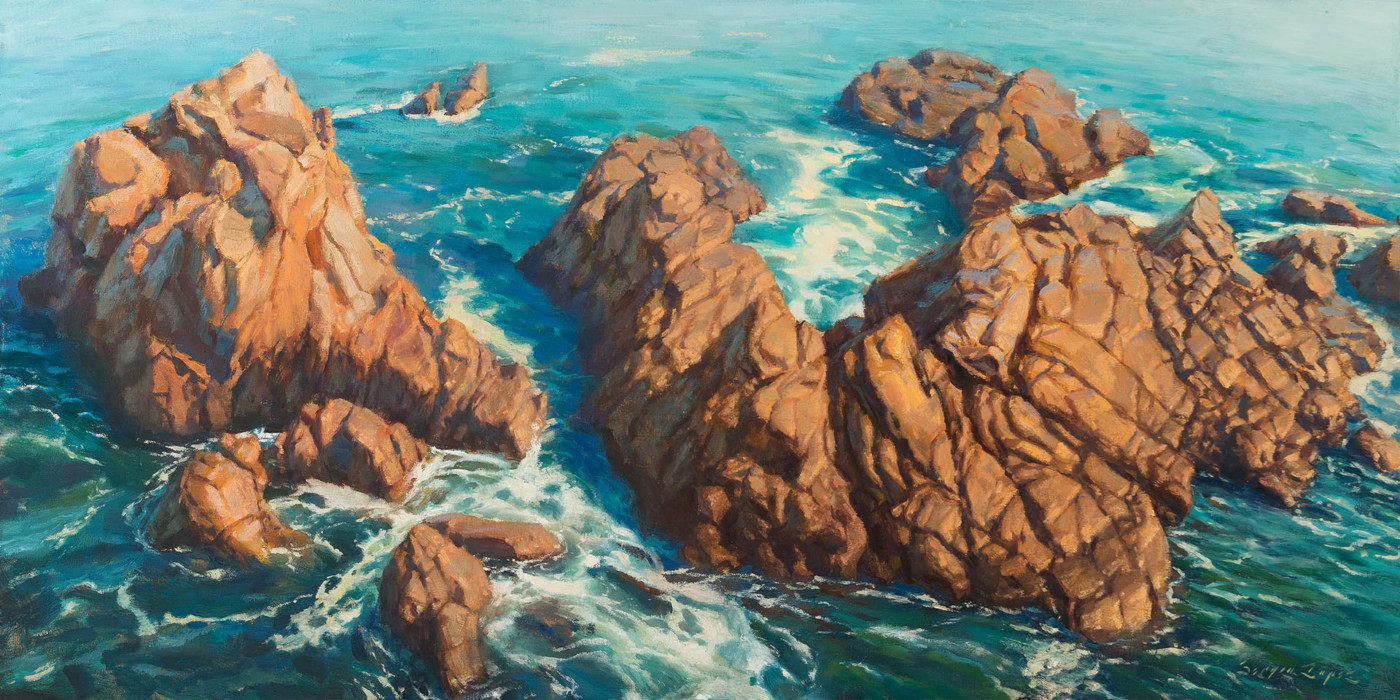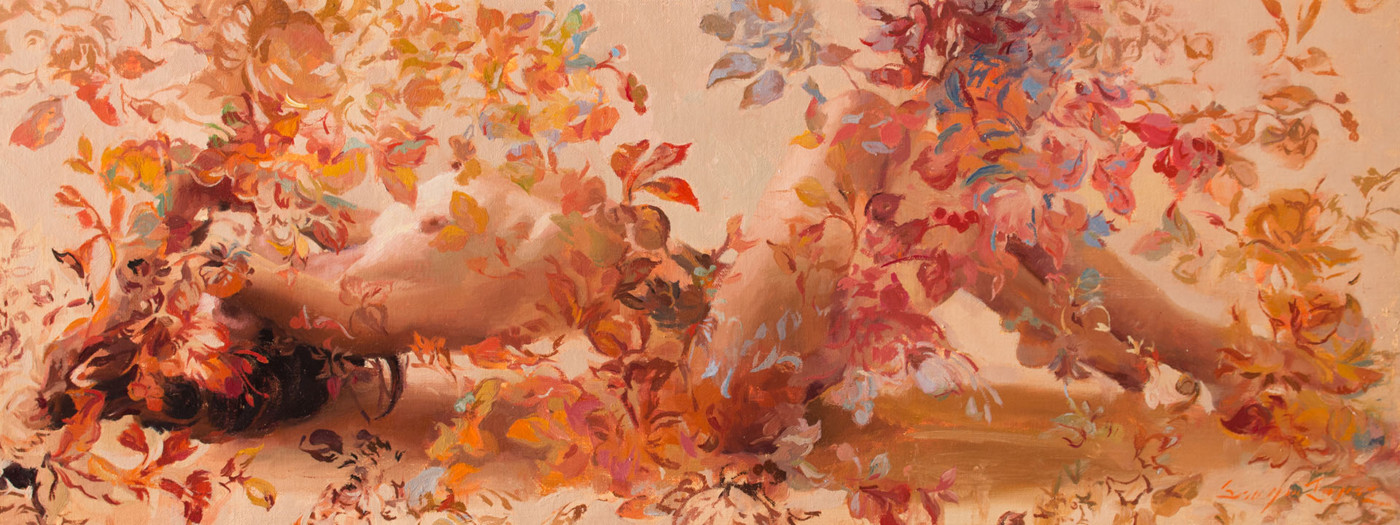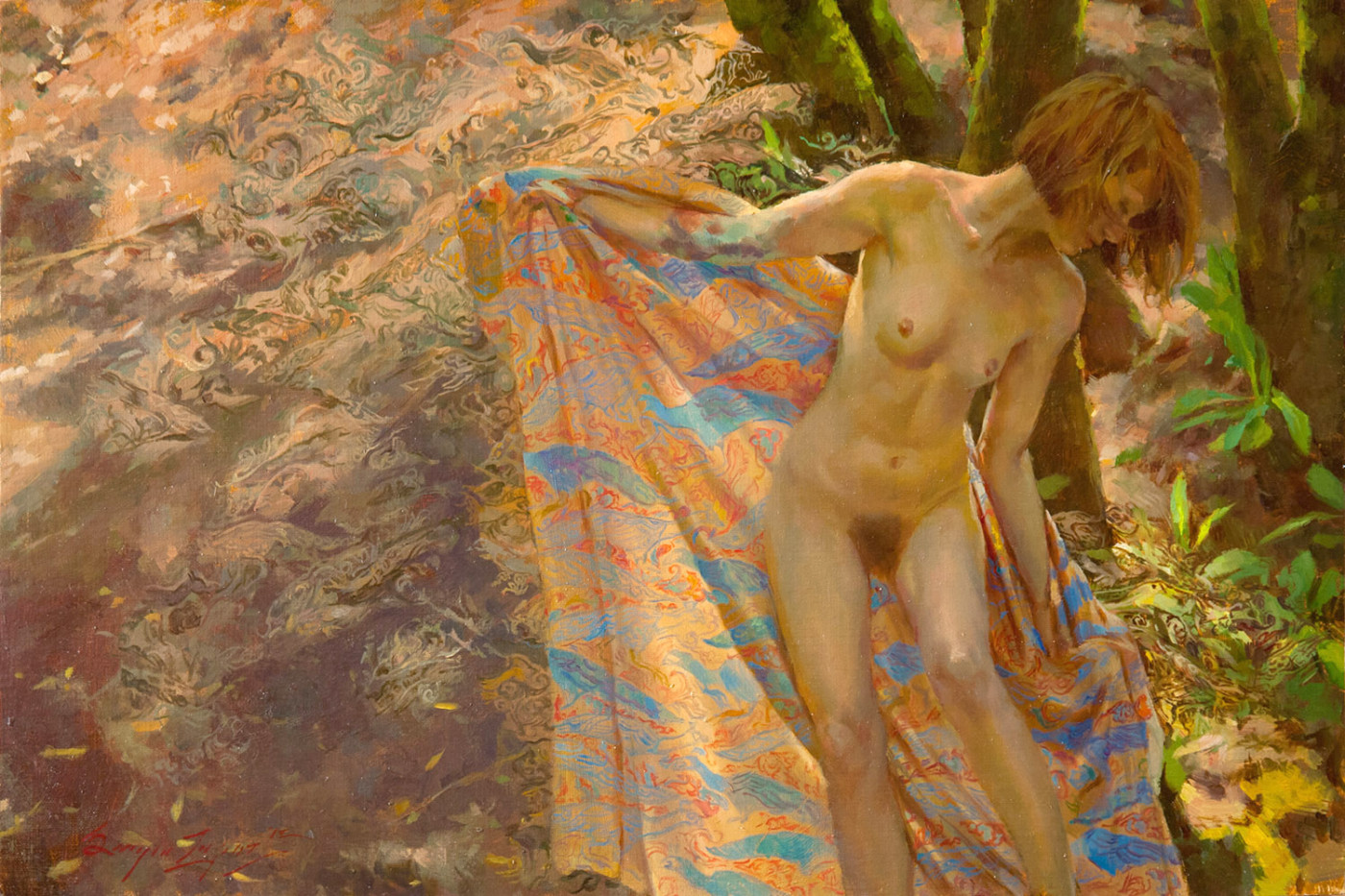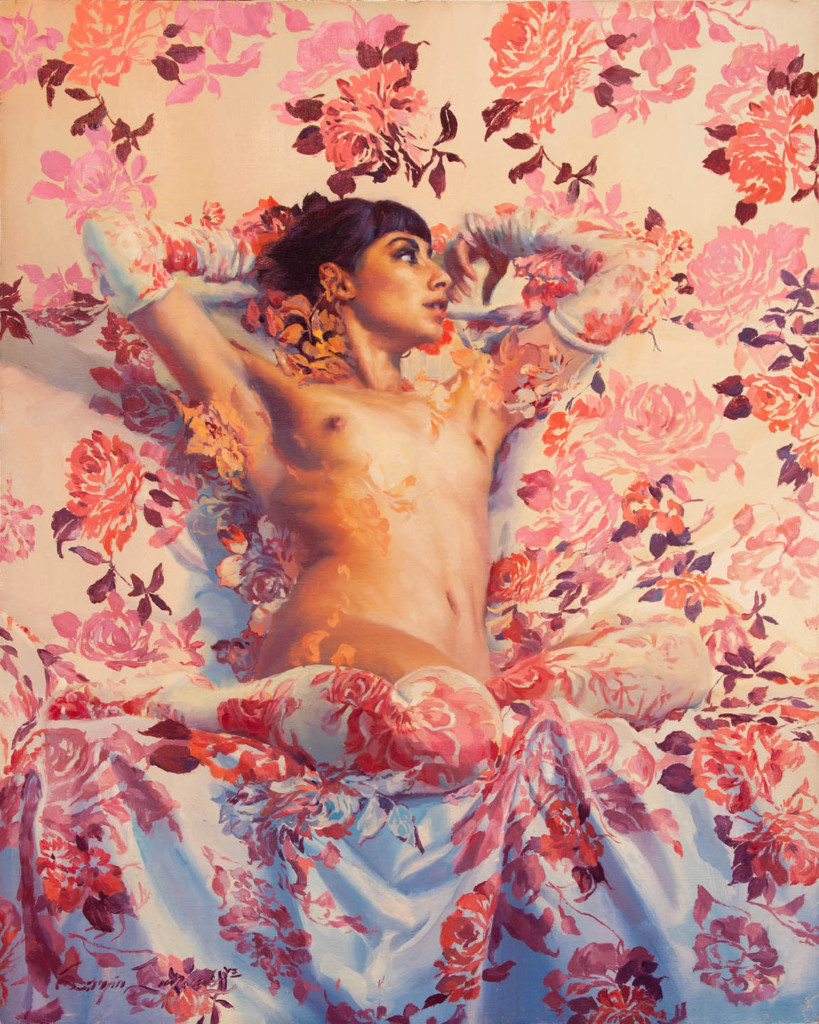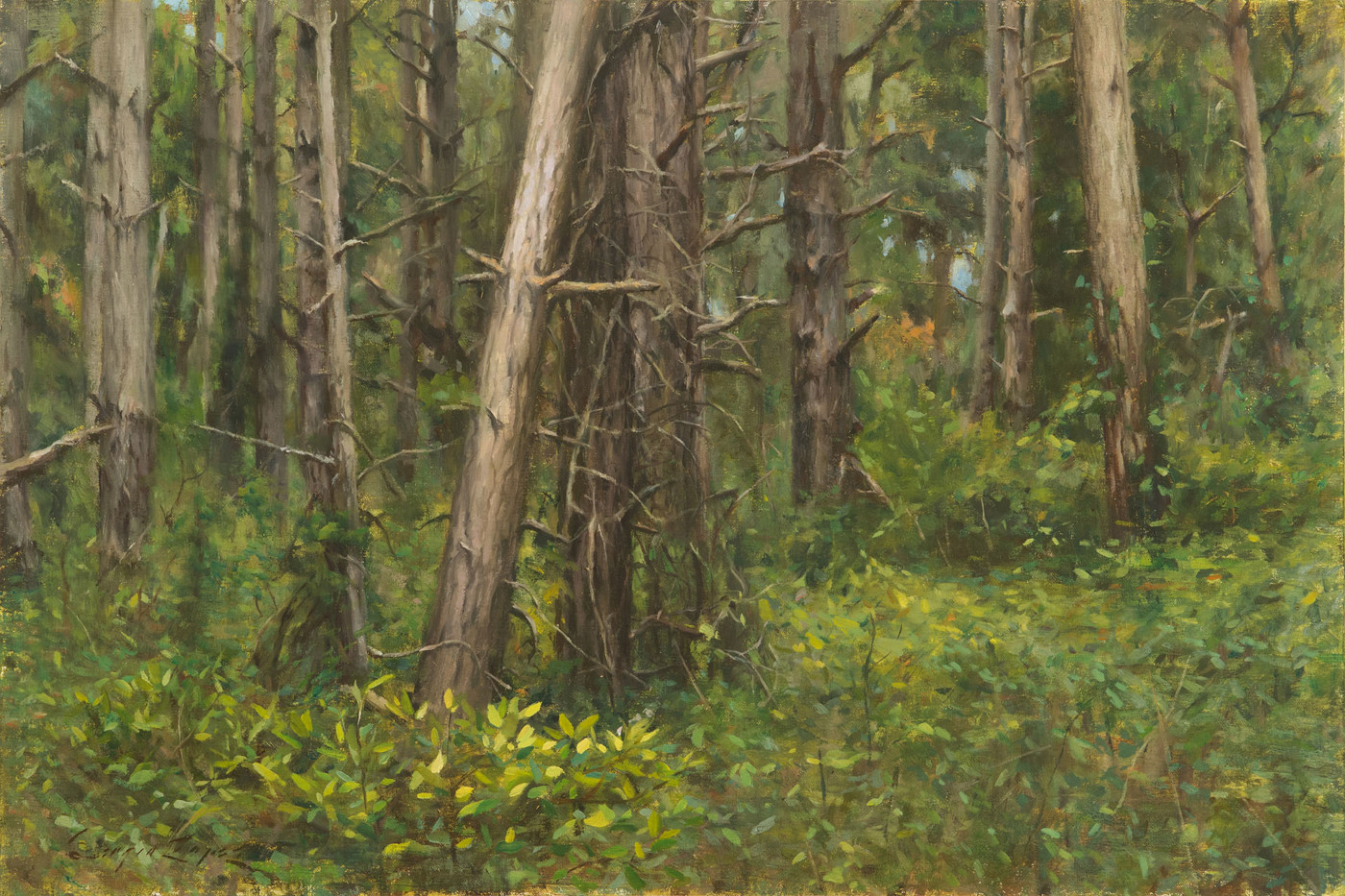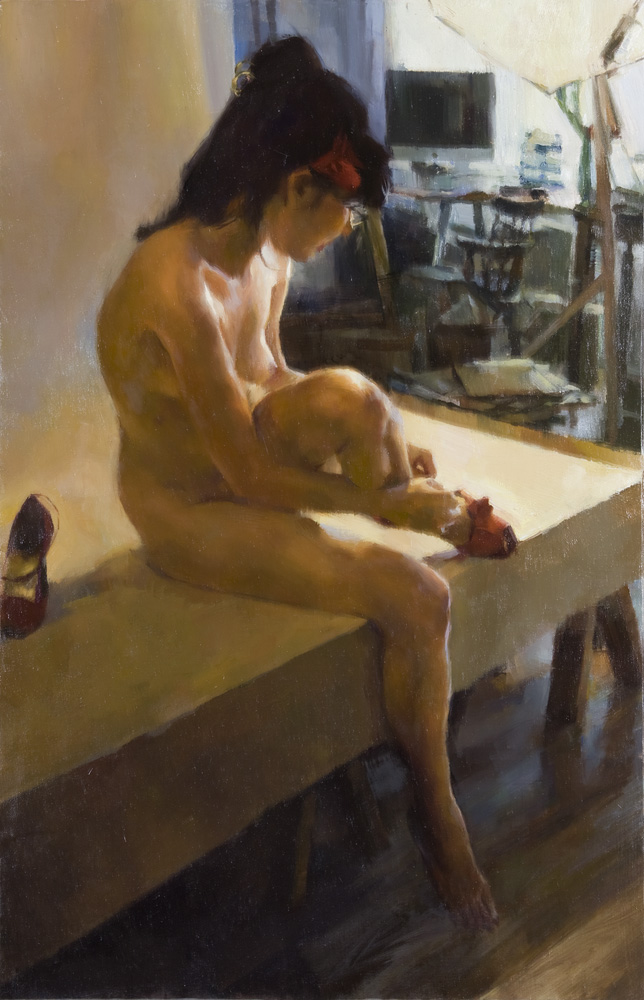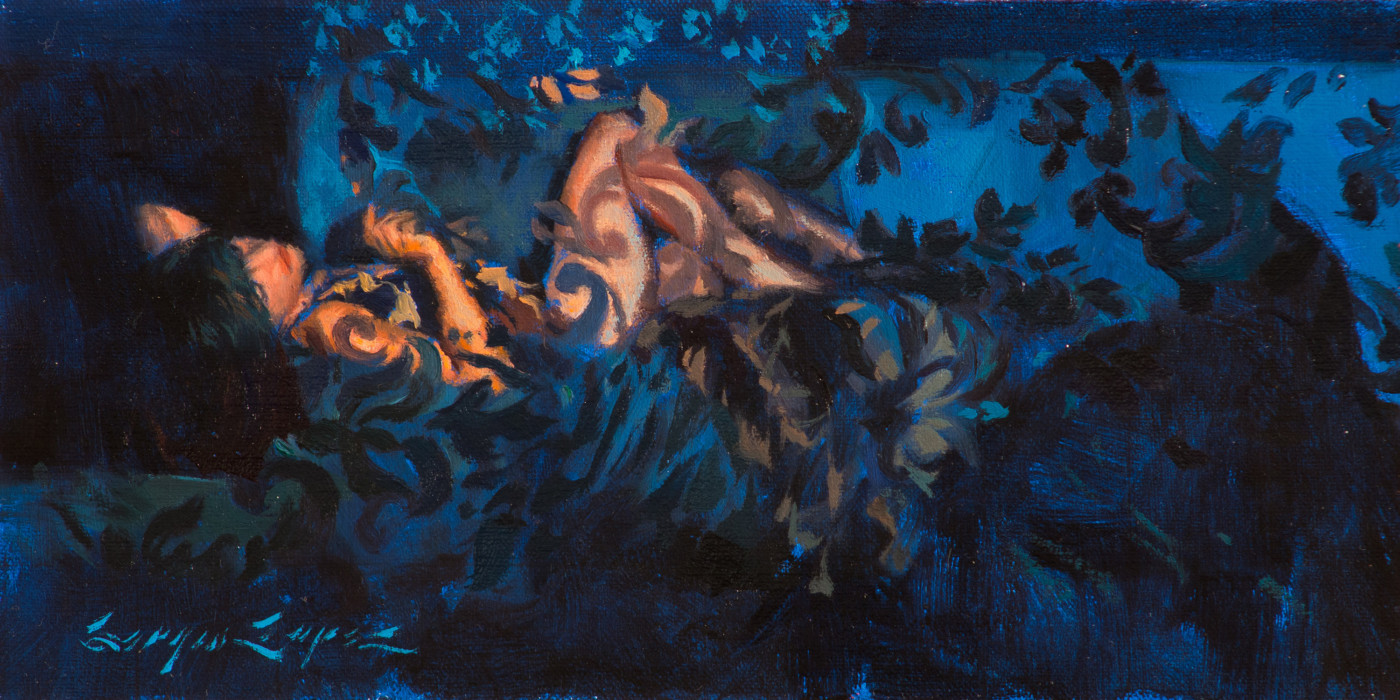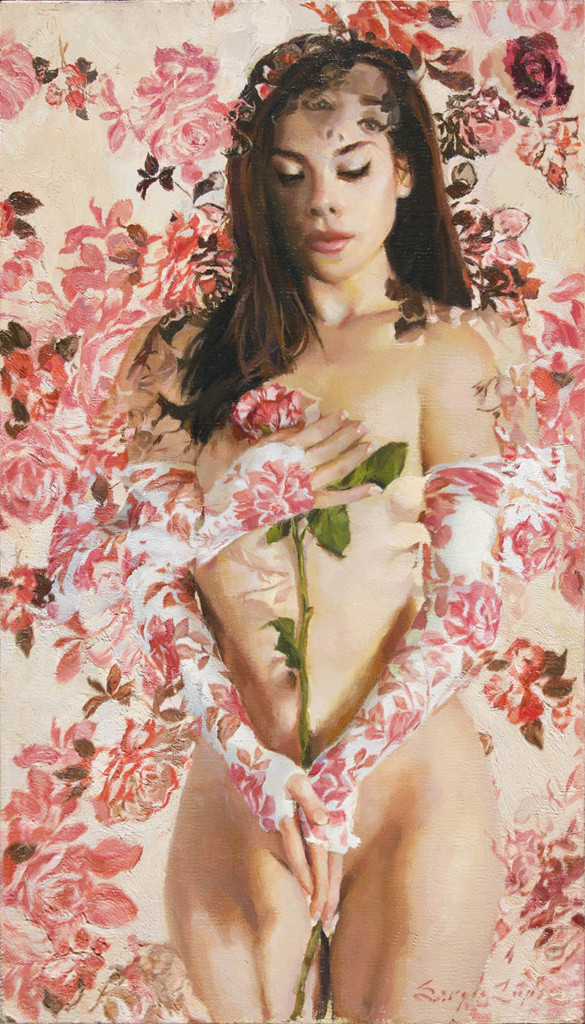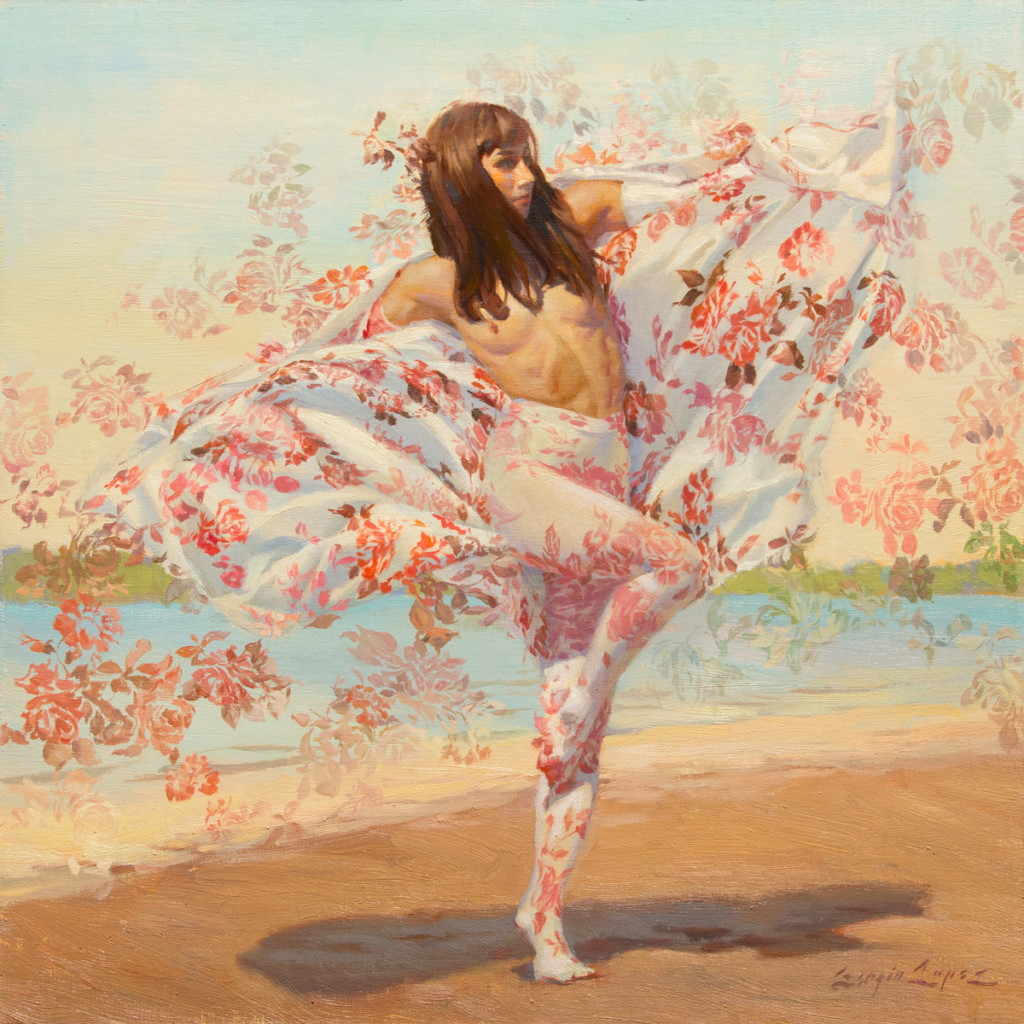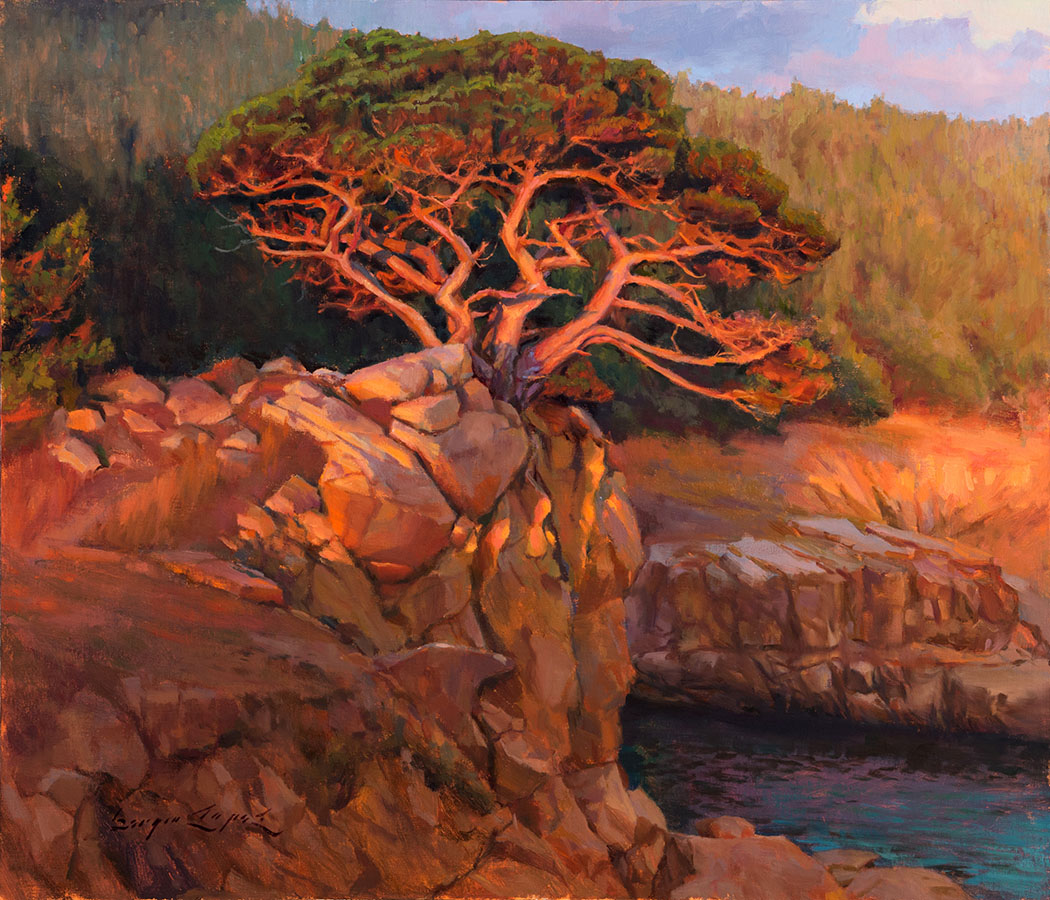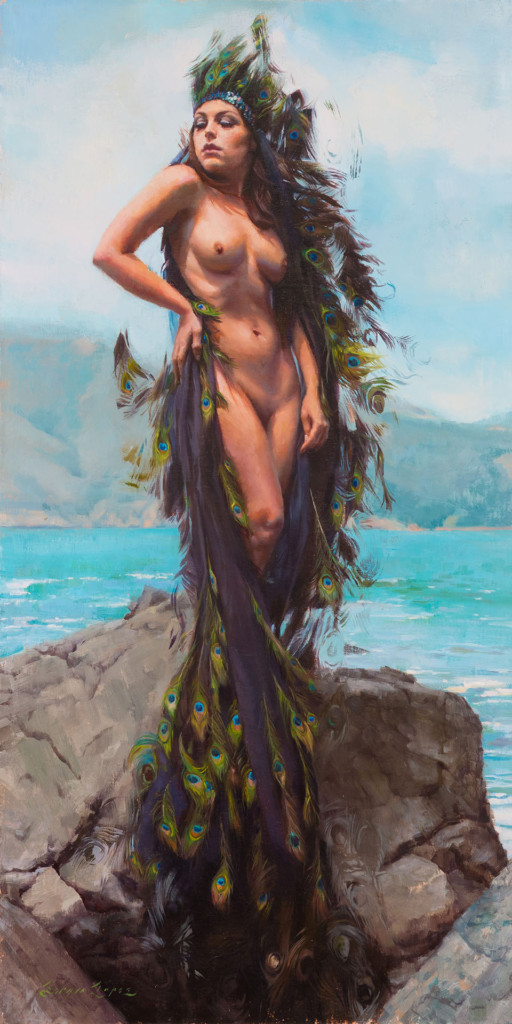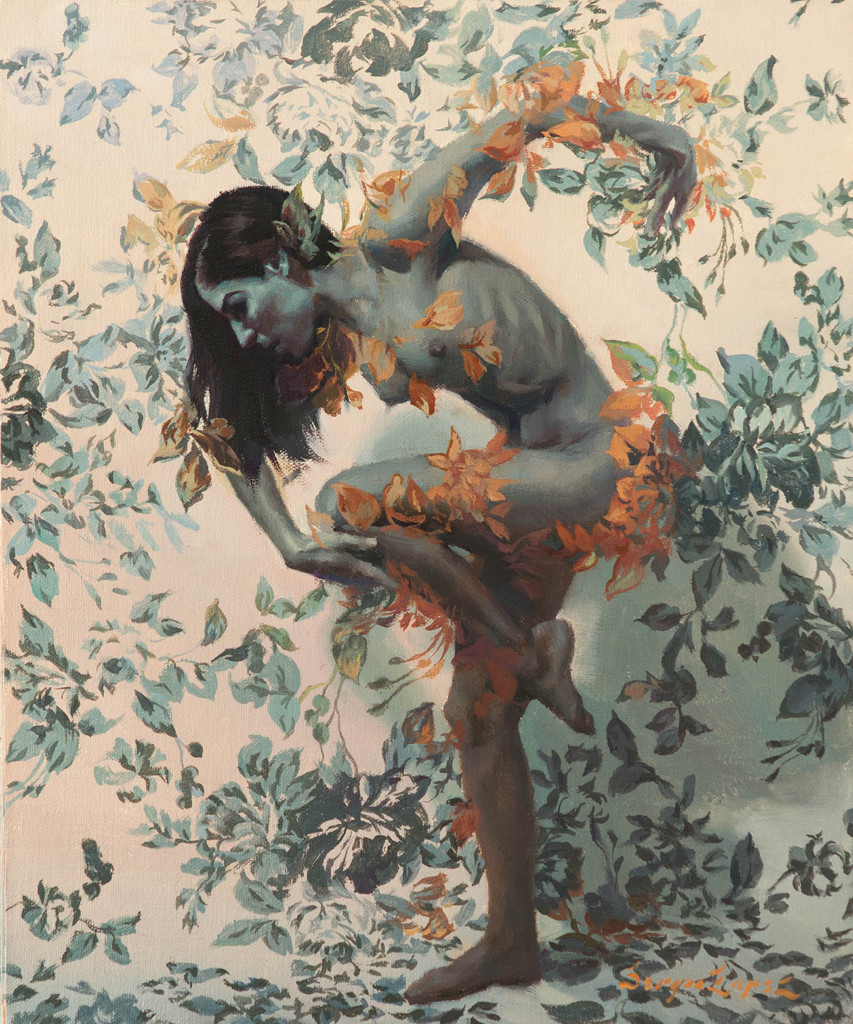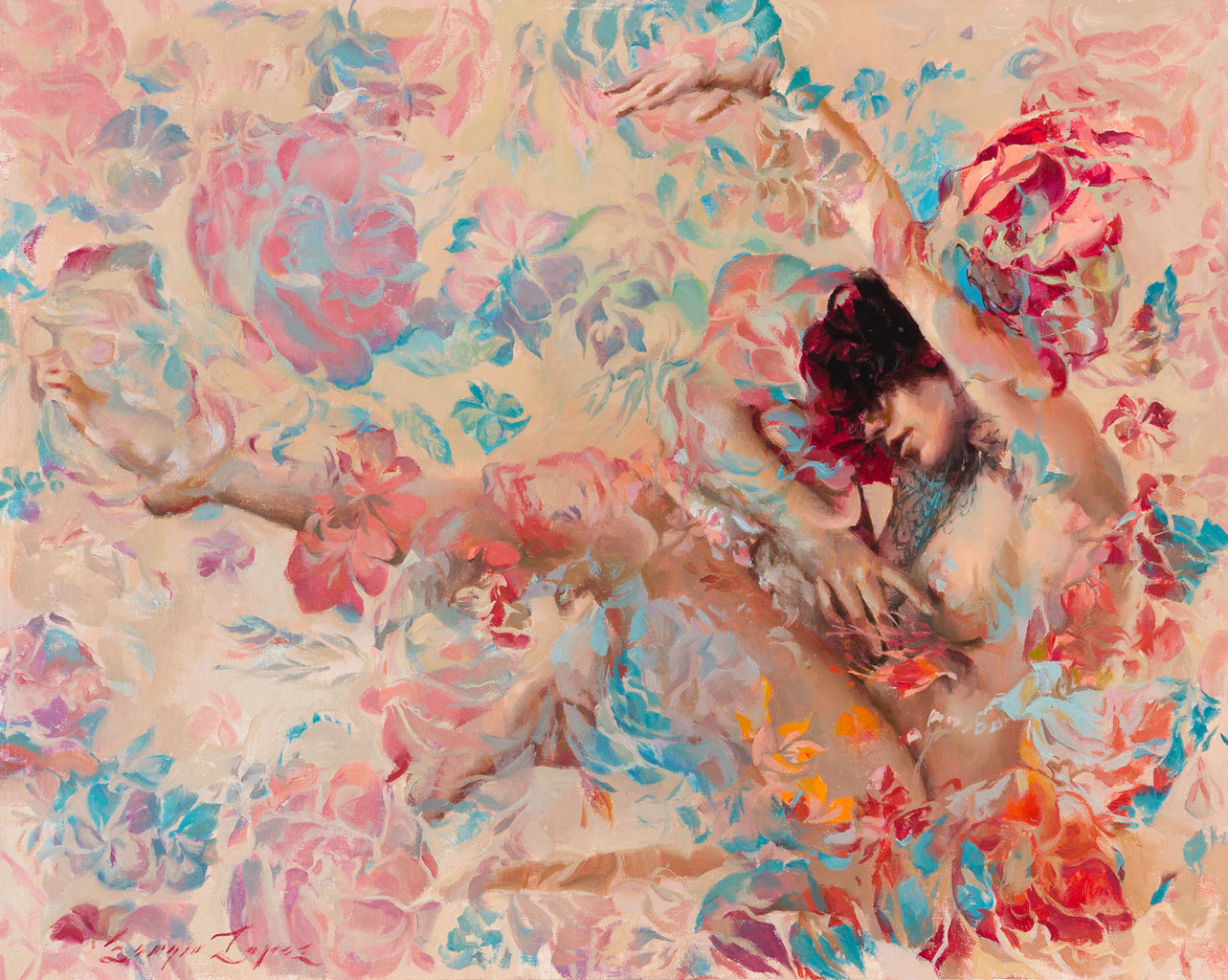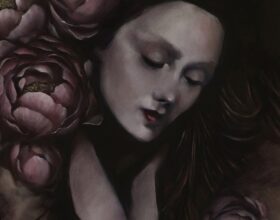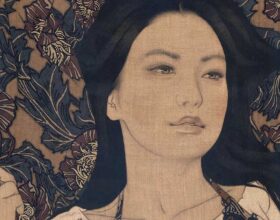A man with the distinct ability to create mystery in every layer, Sergio Lopez brings a fascinating depth of emotion to his paintings. A graduate of the Academy of Art in San Francisco, he is well versed in a range of mediums, with influences as vast as his capabilities. Despite this knowledge, he still prefers working in oil, and his intricate process behind each subject is as absorbing as the finished product. Although his collection of work is admirable, Sergio is perhaps best known for the beautiful female figures he brings to life with each stroke of the brush. Unique and arresting, these beguiling creatures are shrouded in labyrinthine, floral patterns, blending into their efflorescent, vintage surroundings with absolute ease. In this candid interview, for Issue 013 of beautiful.bizarre, he shares his inspirations, what a day is like in the life of an oil painter, and how to balance the digital realm with all things tangible and physical.
Web | Facebook | Tumblr | Instagram | Twitter
b.b: What is the process behind your beautiful paintings?
SL: Well, it depends on what I’m working on. Since most people are interested in my figurative work, I will walk the readers through that process. I try to work only from my own reference photos when possible. I set up my own photo shoots, find my own models, and mostly use props or costumes that I make or procure myself. I find that a critical part of the creative element in my work since I don’t try to invent anything. When my concepts draw upon physical reality, the creativity depends on what I choose to seek and put into my work, and how I arrange it pictorially.
I shoot many photos so that I have a variety of photos to choose from while selecting which poses would make for the best paintings. I can shoot over 1 000 photos in some cases. From there I narrow it down to about the best 15-20 pictures that have potential as paintings. I do colour processing in [Adobe] Lightroom and Photoshop. Then I run various Photoshop filters repeatedly on the photo to get that signature look of patterns appearing to blend in and out of the figure and background. I will then do whatever necessary colour processing and manipulation is still required until I have a photo that I feel confident in producing a finished painting from.
Once I have that, I will transfer that photo to my tablet screen that I paint from when I am in my studio. I typically grid out a canvas to help me do a preliminary drawing that I paint over. It typically takes me 3 to 4 layers to complete a painting. First, the initial block-in, then further refinement of the figure or background, then finessing the patterns, and if still needed more refinement of the entire painting.
b.b: What is a typical day in the life of Sergio Lopez?
A typical day for Sergio Lopez starts with looking at whatever ended up on my phone while I was sleeping, then email, then lunch, then whatever computer work I might have to do, then errands, then studio work such as if I need to build painting panels or whatnot, then I finally start painting until I get hungry. I rest and eat dinner for a couple of hours then I go to the studio to paint until I’m tired and ready for bed. That is a typical day for me.
b.b: What inspires you to create the stunning women, sweeping landscapes and backdrops of your paintings?
SL: It depends on what my subject is. With my landscapes I definitely want to evoke a feeling of ‘being there’. If I can imply extra senses into a landscape painting, I know I’m on the right track. With my figures, it’s a little more nebulous. I purposely try to avoid any lofty ideals and even any overt narrative for the most part. I prefer, not only in my own work, but also in the work I admire, a more ambiguous narrative. I enjoy the mystery of it, and having the ability to have the choice of trying to figure it out. Or not. I believe that the only responsibility of a painting is for it to be beautiful. Not necessarily in theme or concept, but in look and execution.
Devonensis
b.b: Please share a bit about your most recent work, your seamless floral fusions with highly feminine and striking poses? What inspired this series and how do you choose what elements go into each piece, and what ties them together? Is it an organic falling-into-place, or a well-structured plan?
SL: The technique of blending the figure and foreground as a motif was born from my Hip Hop series back in 2009. It came about organically because I wanted to do nudes but I was interested in the technique and the cool effects I was getting in Photoshop. There was a friend who had many tattoos on her back with roses and all sorts of other things, and she brought a vintage rose pattern shawl to use as a backdrop. We came up with that together… without it, I don’t know if the idea would have ever been born!
Coming up with each image is an organic process ran through very specific steps, if that makes sense. The steps themselves I’m keeping close to the chest for now. I’ve found that revealing too much of the computer part of the process takes away some of the magic, for some reason.
b.b: Tell me a bit about how you began painting. Why choose this particular medium to work in, and what are your favourite pieces of your own work to date?
SL: Oil is king. It’s true that I like almost all other mediums, but nothing else gives you the satisfaction of doing a painting in oils. I don’t know if I have any favourites. Greensleeves came out quite well. I was proud of Grace Darlings at the time, but really what motivates me is the anticipation of the awesome paintings that lie ahead.
b.b: In this world of digital everything, do you think traditional artistry will ever ‘go out of fashion’ or be lost on next generations who live out their lives in the Instagram age?
SL: No, traditional art was here long before computers, and will be here long after. I think there is a biological imperative for humans to manipulate their environment using the tools at their disposal, and a computer is just one option. People still doodle if you put a pen in their hand no matter what. I love Instagram, and even on there, most of the people I follow take photos of things they make on paper or canvas.
Seacliff Kingdom
b.b: Following onto that, how do you navigate the digital realm? What parts of it, for example, social media marketing benefit your work, and what are the challenges?
SL: I’ve been using the internet since I was in Junior High, and am usually excited to see how it is evolving and where it’s going. It all benefits me. I don’t really see very many downsides to it personally. Some people get sucked into it too much I guess, and feel the need to disconnect. I don’t know what that feels like. I’ve never had a problem with it. It’s the main avenue that people find me and my work, and the main way I communicate with others. I’m hard at work at the easel most of the time, and so it’s nice to plug in to it every day to see what else is going on in the world and to show what I’m doing over here.
b.b: What are some of the challenges you face on a daily basis with your art, and how do you overcome these issues?
SL: Well, painting never gets ‘easy’. You can just try to get better at the basics all the time, and continue to stretch in terms of technique and concept. I still like to learn when I can. I’d love to take more workshops and go to more museums when I can. Right now I’m really into the ‘why’ behind the concepts of other artists I admire, so I like listening to interviews to hear them discuss these things. It informs me of what sort of things I should be thinking about in order to reach the next level. I think I know enough about technique at this point to last me a while. The next phase of education might be for me to learn more about concept and the less-concrete ideas that have no set path, or right or wrong answer.
Meidiland Roses
b.b: Where do you see the art world headed in the next 5-10 years, and where do you see yourself in that space?
SL: I’m not sure yet about the art world at large. Maybe certain trends will be replaced by then. I think the galleries who will be the most successful are the ones who have the freshest ideas and are the most creative marketers on social media. Competition will continue to grow. Just merely being on social media won’t be enough (it already isn’t); you’ll need to have some sort of hook to be really successful as a business person. Artists with traditional skills will continue to rise in value. Maybe the most successful artists will be the ones who can paint very well traditionally, are strong conceptually, and straddle the line between representational and abstract. Because I see things going that way, I think my work will veer more in that direction.
b.b: Any last words, advice to young artists or useful information you’d like readers to know?
SL: This is more for aspiring artists who want to make their living as artists. Young artists in high school: You’re not working hard enough, but don’t worry about it too much yet. Young artists in college: You’re not working hard enough, start worrying about it. Do something about it, trust me. Young artists just out of art school: This is where the real work begins. You might think you’re working hard, but you’ll be surprised at how much harder you can work, and how much more effort you need to put into your craft and business to make it in the art world. The efforts are worth it though. I am almost 10 years out of school now, and I am working harder now than I ever have, but I’m probably having more fun with my art than I ever have before, so the payoff is worth it.
Sergio will be part of the beautiful.bizarre Invitational Show on September 17, 2016 at the Modern Eden Gallery in San Francisco, CA.
Concordance
Chanelle
Cacophony of Greens
After The Session
Supreme Luminary
Ocean of Blue Lace
Rosenthal
Over Your Sheltered Nest
Maigold
Hugging The Edge
Glittering Train
Futura
Four Seasons


